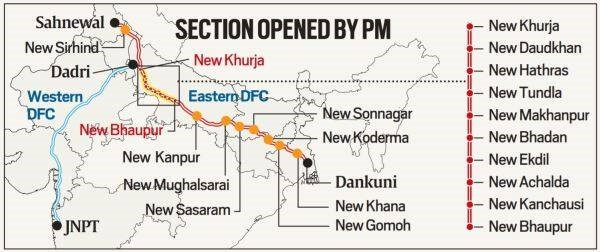Description
Context: Prime Minister inaugurated a 351-km section between Khurja and Bhaupur in Uttar Pradesh for commercial operations of the Dedicated Freight Corridor (DFC).
The total 2,843-km project — billed as the largest rail infrastructure being built in independent India — has been in the making since 2006 with little movement on the ground. It is finally ready to take off, albeit in phases.
What is the DFC?
- The DFC consists of two arms.
- The section is part of the 1,839-km Eastern DFC that starts at Sohnewal (Ludhiana) in Punjab and ends at Dankuni in West Bengal.
- The other arm is the around 1,500-km Western DFC from Dadri in Uttar Pradesh to JNPT in Mumbai, touching all major ports along the way.
- The 351-km section stretches between Khurja, the 12th stop after Sohnewal in the North, to New Bhaupur, near Kanpur.
- Other stretches are Sohnewal to Khurja (365 km), Bhaupur to Pandit Deen Dayal Upadhyay (Mughalsarai) (400 km), then to Sonnagar in West Bengal (137 km), then to Dankuni via Gomoh in Jharkhand (538 km).
Why is it important?
- Around 70% of the freight trains currently running on the Indian Railway network are slated to shift to the freight corridors, leaving the paths open for more passenger trains.
- Built at a cost of Rs 5,750 crore through a loan from World Bank, the new stations in this section are Bhaupur, Kanchausi, Achalda, Ekdil, Bhadan, Makhanpur, Tundla, Hathras, Daudkan and Khurja.
- This is like building an entire railway network from scratch, independent of Indian Railways.
All the installations are new. Including the stations, and that’s why the names of a majority of its stations are prefixed with ‘New’, such as New Bhaupur, New Khurja etc.

https://indianexpress.com/article/explained/explained-why-dedicated-freight-corridor-matters-for-railways-the-country-7125450/












